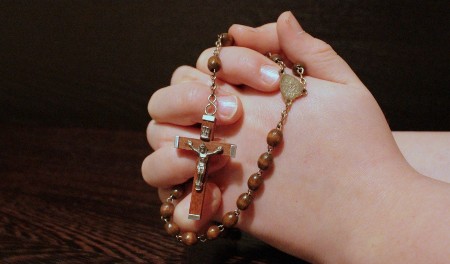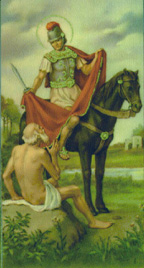We ask you, humbly: don't scroll away.
Hi readers, it seems you use Catholic Online a lot; that's great! It's a little awkward to ask, but we need your help. If you have already donated, we sincerely thank you. We're not salespeople, but we depend on donations averaging $14.76 and fewer than 1% of readers give. If you donate just $5.00, the price of your coffee, Catholic Online School could keep thriving. Thank you.Help Now >
Pasch or Passover
FREE Catholic Classes
Jews of all classes and ways of thinking look forward to the Passover holidays with the same eagerness as Christians do to Christmastide. It is for them the great event of the year. With the exception of the Temple sacrifices, their manner of observing it differs but little from that which obtained in the time of Christ. Directions for keeping the feast were carefully laid down in the Law (see Exodus 12, 13, etc.), and carried out with great exactness after the Exile.
THE PREPARATION
The feast of the Passover begins on the fourteenth day of Nisan (a lunar month which roughly corresponds with the latter part of March and the first part of April) and ends with the twenty-first. The Jews now, as in ancient times, make elaborate preparations for the festival. Every house is subjected to a thorough spring cleaning.
The Saturday preceding the day of the Pasch (fifteenth) is called a "Great Sabbath ", because it is supposed that the tenth day of the month Abib (or Nisan) -- when the Israelites were to select the Paschal lambs, before their deliverance from Egypt -- fell on a Sabbath. On this Sabbath, the day of the following week on which the Passover is to fall is solemnly announced.
Some days before the feast, culinary and other utensils to be used during the festival are carefully and legally purified from all contact with leaven, or leavened bread. They are then said to be kosher. Special sets of cooking and table utensils are not unfrequently kept in every household.
On the evening of the thirteenth, after dark, the head of the house makes the "search for leaven" according to the manner indicated in the Mishna (Tractate Pesachim , I), which is probably the custom followed by the Jews for at least two thousand years. The search is made by means of a lighted wax candle. A piece of ordinary, or leavened, bread is left in some conspicuous place, generally on a window-sill. The search begins by a prayer containing a reference to the command to put away all leaven during the feast. The place of the piece of bread just mentioned is first marked to indicate the beginning of the search. The whole house is then carefully examined, and all fragments of leaven are carefully collected on a large spoon or scoop by means of a brush or bundle of quills. The search is ended by coming back to the piece of bread with which it began. This, also is collected on the scoop. The latter, with its contents, and the brush are then carefully tied up in a bundle and suspended over a lamp to prevent mice from scattering leaven during the night and necessitating a fresh search. The master of the house then proclaims in Aramaic that all the leaven that is in his house, of which he is unaware, is to him no more than dust.
During the forenoon of the next day (fourteenth) all the leaven that remains is burnt, and a similar declaration is made. From this time till the evening of the 22nd, when the feast ends, only unleavened bread is allowed. The legal time when the use of leavened bread was prohibited was understood to be the noon on the fourteenth Nisan; but the rabbis, in order to run no risks, and to place a hedge around the Law, anticipated this by one or two hours.
THE PASCHAL FEAST
On this day, the fourteenth, the first-born son of each family, if he be above thirteen, fasts in memory of the deliverance of the first-born of the Israelites, when the destroying angel passed over Egypt. On the evening of the fourteenth the male members of the family, attired in their best, attend special services in the synagogue.
On their return home they find the house lit up and the Seder , or Paschal Table, prepared. The head of the family takes his place at the head of the table, where there is an arm-chair prepared for him with cushions or pillows. A similar chair is also ready for the mistress of the house. The meal is called Seder by the Ashkenaziac Jews, and Haggadah (because of the story of the deliverance recited during it) by the Sephardic Jews. All the members of the Jewish family, including servants, sit round the table.
In front of the head of the family is the Seder-dish, which is of such a kind as to allow three unleavened cakes or matzoth , each wrapped in a napkin, to be placed on it one above the other. A shank bone of lamb (with a small portion of meat attached) which has been roasted on the coals is placed, together with an egg that has been roasted in hot ashes, on another dish above the three unleavened cakes. The roasted shank represents the Paschal lamb, and the roasted egg the chagigah , or free will offerings, made daily in the Temple. Bitter herbs, such as parsley and horseradish, a kind of sop called charoseth , consisting of various fruits pounded into a mucilage and mixed with vinegar, and salt water, are arranged in different vessels, sometimes disposed like candelabra above the leavened bread. The table is also furnished with wine, and cups or glasses for each person, an extra cup being always left for the prophet Elias, whom they expect as the precursor of the Messiah.
The First CupWhen all are seated around the table the first cup of wine is poured out for each. The head of the house rises and thanks God for the fruits of the vine and for the great day which they are about to celebrate. He then sits down and drinks his cup of wine in a reclining posture, leaning on his left arm. The others drink at the same time. In the time of the Temple the poorest Jew was to drink four cups of wine during this joyful meal; and if he happened to be too poor, it was to be supplied out of public funds. Though four cups are prescribed, the quantity is not restricted to that amount. Some water is generally added to the wine. In early days red wine was used; but on account of the fear of fostering the groundless blood accusations against Jews, this usage was discontinued. Unfermented raisin wine or Palestinian wine is now generally used.
The Bitter Herbs and AfikomanAfter drinking the first cup the master rises and washes his hands, the others remaining seated, and Eldersheim is of the opinion that it was at this point of the supper that Christ washed the disciples feet. After washing his hands, the head of the family sits down, takes a small quantity of bitter herbs, dips them in salt water, and eats them, reclining on his left elbow. Jewish interpreters say that only the first Passover was to be eaten standing, and with circumstances of haste. During the Passovers commemorative of the first they reclined "like a king [or free man ] at his ease, and not as slaves " -- in this probably following the example of the independent Romans with whom they came into contact. After the head of the family has eaten his portion of bitter herbs, he takes similar portions, dips them in salt water, and hands them round to be eaten by the others.
He then takes out the middle unleavened cake, breaks it in two, and hides away one-half under a pillow or cushion, to be distributed and eaten after supper. If this practice existed in the time of Christ, it is not improbable that it was from this portion, called afikoman , that the Eucharist was instituted. As soon as this portion is laid aside, the other half is replaced, the dish containing the unleavened cakes is uncovered, and all, standing up, take hold of the dish and solemnly lift it up, chanting slowly in Aramaic: "This is the bread of affliction which our fathers ate in Egypt. This year here, next year in Jerusalem. This year slaves, next year free."
The Second CupThe dish is then replaced and the shank bone, roasted egg, etc. restored to their places above it. All sit down, and the youngest son asks why this night above all other nights they eat bitter herbs, unleavened bread, and in a reclining posture. The head of the house then tells how their fathers were idolaters when God chose Abraham, how they were slaves in Egypt, how God delivered them, etc. God is praised and blessed for His wondrous mercies to their nation, and this first part of the ceremony is brought to a close by their breaking forth with the recitation of the first part of the Hallel (Psalms 112 and 114) and drinking the second cup of wine, which is triumphantly held aloft and called the cup of the Haggadah or story of deliverance.
The Meal ProperThe ceremony so far has been only introductory. The meal proper now begins. First all wash their hands; the president then recites a blessing over the unleavened cakes, and, after having dipped small fragments of them in salt water, he eats them reclining. He next distributes pieces to the others. He also takes some bitter herbs, dips them in the charoseth , and gives them to the others to be eaten. He next makes a kind of sandwich by putting a portion of horse-radish between two pieces of unleavened bread and hands it around, saying that it is in memory of the Temple and of Hillel, who used to wrap together pieces of the paschal lamb, unleavened bread, bitter herbs, and eat them, in fulfilment of the command of Exodus 12:8.
The supper proper is now served, and consists of many courses of dishes loved by Jews, such as soup, fish, etc., prepared in curious ways unknown to Gentiles. At the end of the meal some of the children snatch the afikoman that has been hidden away, and it has to be redeemed by presents -- a custom probably arising from a mistranslation of the Talmud. It is then divided between all present and eaten. Oesterly and Box think that this is a survival from an earlier time when a part of the paschal lamb was kept to the end and distributed, so as to be the last thing eaten.
The Third CupWhen the afikoman is eaten, the third cup is filled; and grace after meals is said, and the third cup drunk in a reclining posture. A cup of wine is now poured out for the prophet Elias, in a dead silence which is maintained for some time, and the door is opened. Imprecations against unbelievers, taken from the Psalms and Lamentations, are then recited. These were introduced only during the Middle Ages .
The Fourth CupAfter this the fourth cup is filled and the great Hallel (Psalms 115-118) and a prayer of praise are recited. Before drinking the fourth cup, the Jews of some countries recite five poetical pieces and then the fourth cup is drunk. At the end a prayer asking God to accept what they have done is added. Among the German and Polish Jews this prayer is followed by popular songs.
THE REMAINDER OF PASSOVER WEEK
The same ceremonies are observed the next evening. According to the Law the fifteenth and twenty-first were to be kept as solemn festivals and days of rest. At present the fifteenth and sixteenth, the twenty-first and twenty-second are whole holidays, a custom introduced among the Jews of the Dispersion to make sure that they fulfilled the precepts of the Law on the proper day. The other days are half-holidays. Special services are held in the synagogues throughout the Passover week. Formerly the date of the Pasch was fixed by actual observations [Schurer, History of the Jewish People (Edinburgh, 1902), I, II, Append. 3]. It is now deduced from astronomical calculations.
Join the Movement
When you sign up below, you don't just join an email list - you're joining an entire movement for Free world class Catholic education.
-

-
Mysteries of the Rosary
-
St. Faustina Kowalska
-
Litany of the Blessed Virgin Mary
-
Saint of the Day for Wednesday, Oct 4th, 2023
-
Popular Saints
-
St. Francis of Assisi
-
Bible
-
Female / Women Saints
-
7 Morning Prayers you need to get your day started with God
-
Litany of the Blessed Virgin Mary
The Power of the Rosary: Why Praying the Rosary Matters for Catholics
-

Lasers Reveal Hidden Mayan City of Valeriana with 6,500 Structures in Mexico
-

Embracing Peace and Unity in a Time of Division
-
The 'Black Legend': Historian Argues Anti-Catholic Bias in Spanish Conquest Narratives
-
This Catholic Hero Who Fought Against Communism Should Be Released Immediately
Daily Catholic
 Daily Readings for Monday, November 11, 2024
Daily Readings for Monday, November 11, 2024 St. Martin of Tours: Saint of the Day for Monday, November 11, 2024
St. Martin of Tours: Saint of the Day for Monday, November 11, 2024 Prayer for Deceased Veterans: Prayer of the Day for Monday, November 11, 2024
Prayer for Deceased Veterans: Prayer of the Day for Monday, November 11, 2024- Daily Readings for Sunday, November 10, 2024
- St. Leo the Great: Saint of the Day for Sunday, November 10, 2024
- Evening Prayers: Prayer of the Day for Saturday, November 09, 2024
![]()
Copyright 2024 Catholic Online. All materials contained on this site, whether written, audible or visual are the exclusive property of Catholic Online and are protected under U.S. and International copyright laws, © Copyright 2024 Catholic Online. Any unauthorized use, without prior written consent of Catholic Online is strictly forbidden and prohibited.
Catholic Online is a Project of Your Catholic Voice Foundation, a Not-for-Profit Corporation. Your Catholic Voice Foundation has been granted a recognition of tax exemption under Section 501(c)(3) of the Internal Revenue Code. Federal Tax Identification Number: 81-0596847. Your gift is tax-deductible as allowed by law.










 Daily Readings for Monday, November 11, 2024
Daily Readings for Monday, November 11, 2024 St. Martin of Tours: Saint of the Day for Monday, November 11, 2024
St. Martin of Tours: Saint of the Day for Monday, November 11, 2024 Prayer for Deceased Veterans: Prayer of the Day for Monday, November 11, 2024
Prayer for Deceased Veterans: Prayer of the Day for Monday, November 11, 2024


